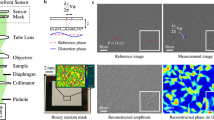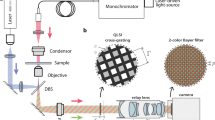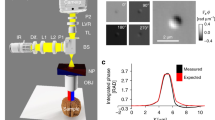Abstract
IN interference microscopy1, contrast in transparent objects is obtained by adding a coherent wave of a certain phase and amplitude to the wave which has passed through the object. In the usual vector representation2, this is equivalent to shifting the origin of the vector circle representing the image. It is clear that, in principle at least, it is possible to add further vectors representing other coherent waves and thus to shift the origin to different new positions. We may thus have consecutive or successive interference contrast.
This is a preview of subscription content, access via your institution
Access options
Subscribe to this journal
Receive 51 print issues and online access
$199.00 per year
only $3.90 per issue
Buy this article
- Purchase on Springer Link
- Instant access to full article PDF
Prices may be subject to local taxes which are calculated during checkout
Similar content being viewed by others
References
Merton, T., Proc. Roy. Soc., A, 189, 309 (1947); A, 191, 1 (1947). Dyson, J., Proc. Roy. Soc., A, 204, 170 (1950). Philpot, J. St. L., “Progress in Biophysics”, 1, 142 (1950).
Barer, R., Proc. Internat. Colloquium on Phase Contrast and Interference Contrast (Paris, 1951): Optita Acta (in the press).
Payne, B. O., J. Roy. Micr. Soc., 70, 255 (1950). Oettlé, A. G., J. Roy. Micr. Soc., 70, 232 (1950).
Author information
Authors and Affiliations
Rights and permissions
About this article
Cite this article
BARER, R. Combined Phase-contrast and Interference-contrast Microscopy. Nature 169, 108–109 (1952). https://doi.org/10.1038/169108a0
Issue Date:
DOI: https://doi.org/10.1038/169108a0
This article is cited by
-
Synthesis of Nucleic Acids and Nuclear Protein in Replicating Animal Cells
Nature (1966)
-
Precise Optical Thickness Measurement of Biological Objects
Nature (1964)
-
Studies of Biochemistry and Physiology of Normal and Tumour Strain Cells: Synthesis of Ribonucleic Acid, Deoxyribonucleic Acid and Nuclear Protein in Normal and Tumour Strain Cells
Nature (1963)
Comments
By submitting a comment you agree to abide by our Terms and Community Guidelines. If you find something abusive or that does not comply with our terms or guidelines please flag it as inappropriate.



